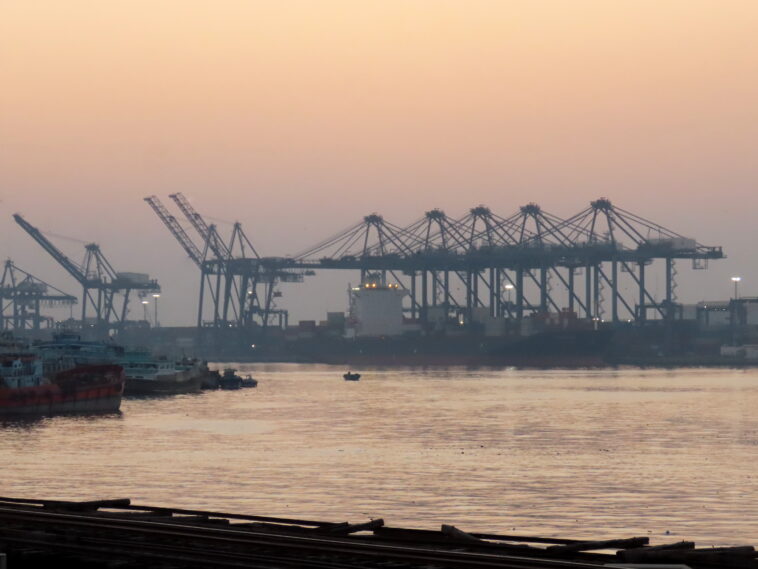Following a rigorous review of operations, the governing authorities declared a 50% deduction on port tariffs at Karachi Port, with the central aim of mitigating trade logistics’ carbon footprint and fostering environmentally-friendly growth. The plan forms a segment of a wider strategy devoted to progressively reducing the carbon emissions of the maritime industry and augmenting the energy efficiency of port tasks. A significant 50% slash in charges for port activities such as handling, ships, and warehousing are at the forefront of these radical reforms. With the previous plans for an annual increment of 5% in these costs now abolished, the primary beneficiaries of this initiative are bulk good exporters. This initiative not only mitigates emissions thanks to quicker, less crowded port dealings but it’s also a boon to the exporters.
This strategic shift towards a greener, more efficient, port management system is imbuing the industry with an unprecedented competitive edge. By reducing both the costs and the logistic complexity of operations, the initiative contributes to fortifying the nation’s climate resilience. An optimised port function implies that ships spend less time idling, consuming less fuel and, hence, turning our supply chains greener. This is simply one aspect of a countrywide tactic devised to upgrade port amenities, augment sustainability standards, and pivot the country towards an era of advanced maritime norms.
The maritime department strives to realize an increase in port competency. Actions put into effect to bring about this change include the establishment of an influential panel to decrease the dwell time of containers by a staggering 70%. Additionally, implementing next-generation technology to keep track of port activities is underway. These strategic changes are undoubtedly aimed at transforming the maritime sphere.
In a bid to encourage domestic blue economy, a state-of-the-art Aquaculture Park is proposed to be constructed near Korangi Fish Harbour (KoFHAH), Karachi. An estimated budget of Rs3 billion has been allotted for this novel project. The product yield from the 120-acre park is projected to range from 360 to 1,200 tons, with fluctuations depending on the breed of fish being farmed and the specific farming technique being employed.
Its annual revenue potential is gauged to oscillate between $720,000 to $7.2 million. The variations in projected revenue will depend heavily on factors such as the types of fish being bred, the fluctuating market rates, and the intensity of production. A partnering of public and private entities will be utilized for the development of this 120-acre project, which is sure to provide a significant surge to the nation’s blue economy through sustainable fish farming.
The coastal waters of Pakistan are renowned for offering highly favourable conditions for aquaculture. This, coupled with the diverse range of marine species that can be farmed, provides a unique opportunity for sustainable aquaculture. A directive has been dispatched instructing all involved parties to submit a comprehensive implementation report within the span of 10 days, indicative of the urgency behind the project.
Should the aquaculture model prove successful, its application and its benefits could potentially seep into other areas. Pakistan’s extensive range of coastal regions provide a golden opportunity for productive and sustainable marine farming. This new administrative approach indicates the potential for improved collaboration between agencies and intends to expedite strategy formulation related to initiatives in the blue economy.
Reforms abound not just in the waters but on the land too, as review processes surrounding the allotment and leasing policies of port authorities are currently in motion. The Survey of Pakistan is actively involved in identifying and demarcating terrains owned by them. Alignments are being made between the revision of the current operational plan and a wider feasibility analysis earmarked for a National Port Master Plan.
Investments channelled into aquaculture and the progressive development of port infrastructure are being lauded as key initiatives for guaranteeing food security, bolstering exports, and creating job opportunities throughout coastal regions. The tide of change in maritime development strategy was ceremonially inaugurated at several key meetings. The emphasis of the revised strategy was clear – fully utilising coastal resources via the melding of cutting-edge innovation, institutional collaboration, and the active participation of private entities.
Major strides have been taken towards a future of sustainable maritime practices. By reducing the cost of doing business and increasing operational efficiency, a perfect balance has been struck between economic development and environmental conscientiousness. The anticipated results include but are not limited to increased competitiveness, enhanced climate resilience, and the evolution of sustainable marine farming.
The proactive engagement and commitment of the maritime ministry towards revolutionizing the maritime industry are clear in the execution of these strategic initiatives. The creation of a well-rounded and efficient monitoring system assisted by advanced technology contributes to hiking up the port’s overall performance. This heightened efficiency, in turn, directly benefits exporters and boosts the nation’s blue economy.
The directives issued by the maritime ministry underline the urgency of transitioning towards innovative, sustainable practices, with a special focus on ensuring optimal utilization of resources. The preliminary projections surrounding the revenue potential generated by the planned Aquaculture Park further reinforce this objective. Naturally, the success of such initiatives will harbour a ripple effect that will benefit other coastal regions as well.
To summarise, shifting towards energy-efficient and environmentally-friendly practices not only reaffirms the nation’s commitment to climate resilience, but also has significant potential to boost the economy. The comprehensive strategy employed, which involves enhancing port infrastructure, investing in sustainable aquaculture, and promoting inter-agency collaboration, promises a brighter future, harnessing the full potential of the nation’s abundant coastal resources.

